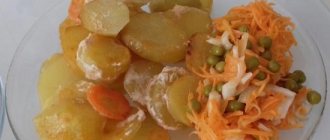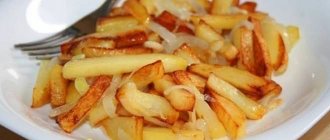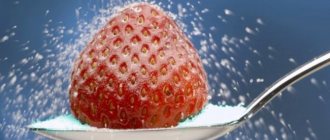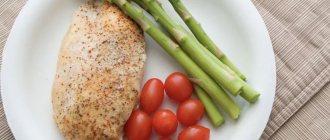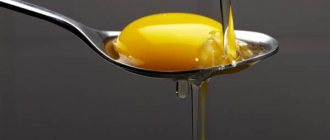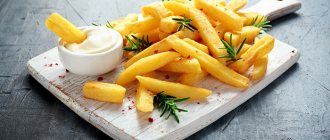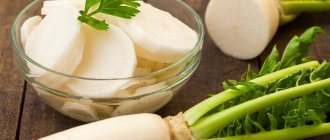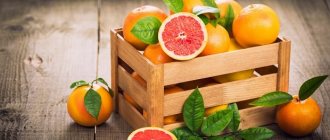Undoubtedly, the most sought-after, popular and widespread vegetable in Russia is potatoes. Every family prepares dishes from the tubers of this plant. He was so loved back in Ancient Rus' that he was called the second bread. This vegetable is very tasty boiled, fried, or baked.
We have been using soups, various casseroles, pies, mashed potatoes, simply boiled crumbly new potatoes and many other dishes in our diet since early childhood. We are so used to seeing this vegetable on our tables that we hardly thought about the nutritional value of potatoes, their calorie content and benefits for the body. Meanwhile, this plant has a rich biological composition.
Properties of French fries
A favorite treat for children and most adults is French fries.
Often in cafes and restaurants it is ordered as a side dish for meat and fish. Some people use it as a snack and take it on picnics. Preparing this dish does not take much time, and it is better to eat it hot so that it does not lose its taste. Unfortunately, French fries cannot be considered a dietary and healthy dish. Sometimes harmful preservatives are used to prepare this dish. The longer potatoes are fried, the more beneficial elements are destroyed in them. Sometimes in cafes this dish is prepared in the same oil several times, which is very harmful. A store-bought dish may contain excess salt, which has a negative effect on the body. You need to remember that you can enjoy this product no more than once a week and not use it daily.
So, the amount of water in French fries noticeably decreases and is only 39.76 g per 100 g of product. The amount of carbohydrates, on the contrary, increases to 34.82 g. The fat content reaches 16.12 g, proteins amount to 3.81 g, and dietary fiber - 4.2 g. Ash is also added to the above components - 1.29 g. The nutritional value of French fries in 100 g is 316 kcal.
Potatoes are rich in complex carbohydrates and fiber
How many calories are in fried potatoes, nutritional value of the dish, how to reduce calorie content when frying
Surely, you already know that carbohydrates are the main source of energy for our body and there is no reason to be afraid of them. In fact, it is recommended that adults get 45 to 65% of their daily calories from carbohydrates.
"Potatoes are a complex carbohydrate," says New York-based nutritionist Amy Gorin. Complex carbohydrates break down more slowly in your body and provide you with stable energy.
Potatoes are also rich in fiber. “Fiber is good not only for keeping you fuller longer, but also for increasing good cholesterol,” says Gorin. A medium-sized potato contains 4 grams of fiber. It should be noted that the most useful part of the potato is in the skin. So for maximum benefit, be sure to eat the whole potato.
Benefits and harms
Beneficial properties of the root vegetable:
- improves digestion;
- thanks to the content of potassium and magnesium, it strengthens the heart and blood vessels, removes excess fluid, helps regulate blood pressure;
- has an anti-inflammatory effect;
- helps cope with vitamin deficiency;
- prevents the development of respiratory diseases;
- increases performance;
- helps strengthen bones and teeth;
- accelerates the removal of toxic substances from the body;
- thanks to the content of B vitamins, it strengthens the nervous system, helps maintain skin and hair in ideal condition;
- Folic acid in potatoes promotes proper intrauterine development of the fetus and strengthens the mother's immunity.
Advice
To get the maximum benefit, you should eat potatoes with their skins on – this is where most of all the valuable compounds are concentrated.
Baking in their uniforms is recognized as the best way to prepare tubers. Nutritionists consider crushed potatoes to be the least healthy - such a dish is poorly filling and contains a minimum of vitamins and minerals.
Harmful properties of the root vegetable:
- may lead to the formation of excess fat deposits if consumed in excess;
- Cooked tubers have a high glycemic index and increase blood glucose levels.
Damage from tubers can be minimized by:
- Combine potatoes and fiber-rich vegetables (cucumbers, cabbage, radishes) in one meal.
- Use the product no more than 3 times a week, 200-250 g.
Do not be afraid to eat potatoes - in the absence of contraindications and with moderate consumption, tubers will only bring benefits to the body, because potatoes are superior in vitamin and mineral composition to less accessible overseas fruits and vegetables. Regular consumption of potatoes will help not only save your family budget, but also improve your health.
Report errors and inaccuracies
Sorrel: beneficial properties and contraindications, useful recipes
Potato
- Pieces 0.4 tubers 5-8 cm in diameter
- Weight with waste 133.3 g Waste: peel and eyes (25% of weight). The calculations use the weight of only the edible part of the product.
Average consumption rates
Listed below are the nutrient standards that apply to the site.
| Nutrient | Norm |
| Essential Nutrients | |
| Squirrels | 75 g |
| Fats | 84 g |
| Carbohydrates | 310 g |
| Calories | 2 300 kcal |
| Minerals | |
| Calcium | 1,000 mg |
| Iron | 10 mg |
| Magnesium | 400 mg |
| Phosphorus | 700 mg |
| Potassium | 4,700 mg |
| Sodium | 1,300 mg |
| Zinc | 11 mg |
| Copper | 0.9 mg |
| Manganese | 2.3 mg |
| Selenium | 55 mcg |
| Fluorine | 4,000 mcg |
| Vitamins (fat soluble) | |
| Vitamin A | 900 mcg |
| Beta carotene | 5,000 mcg |
| Alpha carotene | 5,000 mcg |
| Vitamin D | 15 mcg |
| Vitamin D2 | 7.5 mcg |
| Vitamin D3 | 16.25 mcg |
| Vitamin E | 14.6 mg |
| Vitamin K | 120 mcg |
| Vitamins (water soluble) | |
| Vitamin C | 90 mg |
| Vitamin B1 | 1.2 mg |
| Vitamin B2 | 1.3 mg |
| Vitamin B3 | 16 mg |
| Vitamin B4 | 500 mg |
| Vitamin B5 | 5 mg |
| Vitamin B6 | 1.3 mg |
| Vitamin B9 | 400 mcg |
| Vitamin B12 | 2.4 mcg |
| Amino acids | |
| Tryptophan | 0.8 g |
| Threonine | 2.4 g |
| Isoleucine | 2 g |
| Leucine | 4.6 g |
| Lysine | 4.1 g |
| Methionine | 1.8 g |
| Cystine | 1.8 g |
| Phenylalanine | 4.4 g |
| Tyrosine | 4.4 g |
| Valin | 2.5 g |
| Arginine | 6.1 g |
| Histidine | 2.1 g |
| Alanin | 6.6 g |
| Aspartic | 12.2 g |
| Glutamic | 13.6 g |
| Glycine | 3.5 g |
| Proline | 4.5 g |
| Serin | 8.3 g |
Source
What does it consist of?
Nutritional and energy value
Here is a table that shows how much fat, protein and carbohydrates (BZHU) are contained in raw, boiled, baked or fried potatoes. The nutritional and energy value of raw and cooked potatoes is different.
| Cooking method | Content of calories and nutrients (BJU) per 100 g | |||
| Kcal | Squirrels | Fats | Carbohydrates | |
| Raw potatoes | 80 | 2 | 0,4 | 16,1 |
| Boiled | 82 | 2 | 0,4 | 17,0 |
| Baked | 95 | 2,7 | 2,36 | 17,5 |
| Fried | 192 | 2,8 | 9,5 | 23,4 |
The table shows the average values. The nutritional value of cooked potatoes depends on the duration of cooking and the amount of oil used (when frying).
Glycemic index
The glycemic index (GI) of root vegetables depends on the cooking method.
| Method of preparing potatoes | GI, units |
| Boiled | 70 |
| Boiled in "uniform" | 65 |
| Fried in oil | 95 |
| Mashed potatoes | 90 |
What percentage of starch is in tubers?
What determines the starch content in tubers? The starch content of potatoes directly depends on its variety:
- The varieties Fermer, Limonka, Nevsky, Sante, Impala are characterized by low starch content (10-13%).
- High starchy content (14-25%) is inherent in the varieties Cardinal, Asterix, Krasa, Vector, Hostess, Mozart, Skazka.
- The varieties Kolpashevsky and Zarevo have a high starch content (more than 25%).
Water and dry matter content
Attention!
100 g of tubers contain 78.6 g of water, dry matter accounts for about 21% of the mass of the product.
It is in the dry matter that the following are concentrated:
- nutrients;
- vitamins and minerals;
- saturated and unsaturated fatty acids;
- enzymes;
- alimentary fiber.
What vitamins are included?
Potatoes contain many useful vitamins: A, C, group B and others.
The product contains vitamins:
- A – 3 mcg.
- B1 (thiamine) – 0.12 mg.
- B2 (riboflavin) – 0.07.
- B4 (choline) – 11 mg.
- B5 (pantothenic acid) – 0.3 mg.
- B6 (pyridoxine) – 0.3.
- B9 (folic acid) – 8 mcg.
- C (ascorbic acid) – 20 mg.
- H (biotin) – 0.1 mcg.
- RR – 1.8 mg.
- Nicotinic acid – 1.3 mg.
What useful microelements does it consist of?
The root vegetable contains:
- iron – 0.9 mg;
- silicon – 50 mg;
- zinc – 0.36 mg;
- manganese – 0.17 mg;
- chromium – 10 mcg;
- fluoride – 30 mcg;
- molybdenum – 8 mcg;
- selenium – 0.3 mcg;
- boron – 115 mcg;
- vanadium – 149 mcg;
- cobalt – 5 mcg;
- lithium – 77 mcg;
- copper – 140 mcg;
- aluminum – 860 mcg;
- iodine – 5 mcg;
- nickel – 5 mcg.
Attention!
Silicon deserves special attention: 100 g of potatoes contains more than 150% of the daily intake of this element
Macronutrients
Macronutrient composition of potatoes:
- potassium – 568 mg;
- calcium – 10 mg;
- magnesium – 23 mg;
- phosphorus – 58 mg;
- sodium – 5 mg;
- sulfur – 32 mg;
- chlorine – 58 mg.
Potatoes are considered an excellent source of potassium: the potassium content in 100 grams of root vegetables is more than 20% of the daily intake of this substance.
Potatoes calorie content. Chemical composition and nutritional value.
Jasmine essential oil properties beneficial properties
Potatoes are rich in vitamins and minerals such as: vitamin B6 - 15%, vitamin C - 22.2%, potassium - 22.7%, silicon - 166.7%, cobalt - 50%, copper - 14%, molybdenum - 11 .4%, chromium - 20%
- Vitamin B6 is involved in maintaining the immune response, processes of inhibition and excitation in the central nervous system, in the transformation of amino acids, the metabolism of tryptophan, lipids and nucleic acids, promotes the normal formation of red blood cells, and maintaining normal levels of homocysteine in the blood. Insufficient intake of vitamin B6 is accompanied by decreased appetite, impaired skin condition, and the development of homocysteinemia and anemia.
- Vitamin C is involved in redox reactions, the functioning of the immune system, and promotes the absorption of iron. Deficiency leads to loose and bleeding gums, nosebleeds due to increased permeability and fragility of blood capillaries.
- Potassium is the main intracellular ion that takes part in the regulation of water, acid and electrolyte balance, and is involved in the processes of conducting nerve impulses and regulating blood pressure.
- Silicon is included as a structural component in glycosaminoglycans and stimulates collagen synthesis.
- Cobalt is part of vitamin B12. Activates enzymes of fatty acid metabolism and folic acid metabolism.
- Copper is part of enzymes that have redox activity and are involved in the metabolism of iron, stimulates the absorption of proteins and carbohydrates. Participates in the processes of providing oxygen to the tissues of the human body. Deficiency is manifested by disturbances in the formation of the cardiovascular system and skeleton, and the development of connective tissue dysplasia.
- Molybdenum is a cofactor for many enzymes that ensure the metabolism of sulfur-containing amino acids, purines and pyrimidines.
- Chromium is involved in the regulation of blood glucose levels, enhancing the effect of insulin. Deficiency leads to decreased glucose tolerance.
You can see a complete guide to the healthiest foods in the “My Healthy Diet” app.
Energy value, or calorie content, is the amount of energy released in the human body from food during the digestion process. The energy value of the product is measured in kilocalories (kcal) or kilojoules (kJ) per 100 grams. product. The kilocalorie used to measure the energy value of food is also called a food calorie, so when caloric content is reported in (kilo)calories, the prefix kilo is often omitted. You can see detailed energy value tables for Russian products here.
Nutritional value - the content of carbohydrates, fats and proteins in the product.
The nutritional value of a food product is a set of properties of a food product, the presence of which satisfies a person’s physiological needs for essential substances and energy.
Vitamins, organic substances required in small quantities in the diet of both humans and most vertebrates. Vitamin synthesis is usually carried out by plants, not animals. A person's daily requirement for vitamins is only a few milligrams or micrograms. Unlike inorganic substances, vitamins are destroyed by strong heat. Many vitamins are unstable and are “lost” during cooking or food processing.
Source
Main features of the vegetable
Due to its rich composition, potatoes also have healing properties. Thus, it is recommended for use by those suffering from diabetes. This root vegetable can stimulate human brain activity and can reduce blood cholesterol levels. Those suffering from gastritis and stomach ulcers can safely eat boiled potatoes, as they do not irritate the mucous membrane. If someone has a metabolic disorder, then potatoes, with their alkaline abilities, neutralize the effects of acids. Microelements contained in vegetables prevent kidney disease and protect the immune system.
Potatoes are especially beneficial for the skin when used externally. It protects the skin from the appearance of age spots and can reduce inflammation.
Everyone knows that it is a source of fiber. The vegetable has a positive effect on the nervous system and relieves stress.
Although this is a high-calorie product, it is included in many diets and used on fasting days. Such activities help to lose weight and maintain normal weight.
Will potatoes harm your figure?
Since most people's interest in the energy value of this product arises from the perspective of losing weight, it is worth talking about how exactly these notorious 70-80 kcal affect fat deposits and weight in general.
The reason why nutritionists advise not to overuse potatoes is not the calorie content, but the high proportion of starch (almost 30%) in the chemical composition of the tubers.
In addition, it also contains sugars (glucose, fructose, sucrose, a little maltose), which accumulate during long-term storage. Starch, on the contrary, is destroyed. Accordingly, the calorie content of young potatoes is less than that of old ones.
In 100 g of boiled potatoes you can find 16.7 g of carbohydrates, as well as 2 g of proteins. There is almost no fat here - only 0.4 g.
CHEMICAL COMPOSITION AND NUTRITIONAL ANALYSIS
Nutritional value and chemical composition of “Boiled potatoes 1-206”.
The table shows the nutritional content (calories, proteins, fats, carbohydrates, vitamins and minerals) per 100 grams of edible portion.
| Nutrient | Quantity | Norm** | % of the norm in 100 g | % of the norm in 100 kcal | 100% normal |
| Calorie content | 75 kcal | 1684 kcal | 4.5% | 6% | 2245 g |
| Squirrels | 2 g | 76 g | 2.6% | 3.5% | 3800 g |
| Fats | 0.4 g | 56 g | 0.7% | 0.9% | 14000 g |
| Carbohydrates | 15.8 g | 219 g | 7.2% | 9.6% | 1386 g |
| Alimentary fiber | 1.4 g | 20 g | 7% | 9.3% | 1429 g |
| Water | 78.9 g | 2273 g | 3.5% | 4.7% | 2881 g |
| Ash | 1.3 g | ~ | |||
| Vitamins | |||||
| Vitamin A, RE | 3 mcg | 900 mcg | 0.3% | 0.4% | 30000 g |
| beta carotene | 0.02 mg | 5 mg | 0.4% | 0.5% | 25000 g |
| Vitamin B1, thiamine | 0.1 mg | 1.5 mg | 6.7% | 8.9% | 1500 g |
| Vitamin B2, riboflavin | 0.06 mg | 1.8 mg | 3.3% | 4.4% | 3000 g |
| Vitamin B4, choline | 13.2 mg | 500 mg | 2.6% | 3.5% | 3788 g |
| Vitamin B5, pantothenic | 0.509 mg | 5 mg | 10.2% | 13.6% | 982 g |
| Vitamin B6, pyridoxine | 0.269 mg | 2 mg | 13.5% | 18% | 743 g |
| Vitamin B9, folates | 9 mcg | 400 mcg | 2.3% | 3.1% | 4444 g |
| Vitamin C, ascorbic acid | 14.5 mg | 90 mg | 16.1% | 21.5% | 621 g |
| Vitamin E, alpha tocopherol, TE | 0.1 mg | 15 mg | 0.7% | 0.9% | 15000 g |
| Vitamin K, phylloquinone | 2.1 mcg | 120 mcg | 1.8% | 2.4% | 5714 g |
| Vitamin RR, NE | 1.5 mg | 20 mg | 7.5% | 10% | 1333 g |
| Niacin | 1.1 mg | ~ | |||
| Macronutrients | |||||
| Potassium, K | 499 mg | 2500 mg | 20% | 26.7% | 501 g |
| Calcium, Ca | 12 mg | 1000 mg | 1.2% | 1.6% | 8333 g |
| Magnesium, Mg | 22 mg | 400 mg | 5.5% | 7.3% | 1818 |
| Sodium, Na | 95 mg | 1300 mg | 7.3% | 9.7% | 1368 g |
| Sera, S | 17.1 mg | 1000 mg | 1.7% | 2.3% | 5848 g |
| Phosphorus, Ph | 54 mg | 800 mg | 6.8% | 9.1% | 1481 g |
| Microelements | |||||
| Iron, Fe | 0.8 mg | 18 mg | 4.4% | 5.9% | 2250 g |
| Manganese, Mn | 0.14 mg | 2 mg | 7% | 9.3% | 1429 g |
| Copper, Cu | 167 mcg | 1000 mcg | 16.7% | 22.3% | 599 g |
| Selenium, Se | 0.3 mcg | 55 mcg | 0.5% | 0.7% | 18333 g |
| Zinc, Zn | 0.27 mg | 12 mg | 2.3% | 3.1% | 4444 g |
| Digestible carbohydrates | |||||
| Starch and dextrins | 14.9 g | ~ | |||
| Mono- and disaccharides (sugars) | 0.9 g | max 100 g | |||
| Saturated fatty acids | |||||
| Saturated fatty acids | 0.1 g | max 18.7 g | |||
| Polyunsaturated fatty acids | |||||
| Omega-3 fatty acids | 0.01 g | from 0.9 to 3.7 g | 1.1% | 1.5% | |
| Omega-6 fatty acids | 0.032 g | from 4.7 to 16.8 g | 0.7% | 0.9% |
The energy value of boiled potatoes according to 1-206 is 75 kcal.
** This table shows the average levels of vitamins and minerals for an adult. If you want to know the norms taking into account your gender, age and other factors, then use the My Healthy Diet app.
Substances in raw potatoes
| Substance name | Amount of substance in 100 g of raw potatoes, mg |
| Macronutrients | |
| Potassium | 328 |
| Chlorine | 40 |
| Phosphorus | 40 |
| Calcium | 8 |
| Silicon | 50 |
| Sulfur | 32 |
| Sodium | 4–11 |
| Magnesium | 11–28 |
| Microelements | |
| Bor | 0,115 |
| Zinc | 0,27 |
| Chromium | 0,01 |
| Vanadium | 0,149 |
| Iron | 0,31 |
| Selenium | 0,0003 |
| Nickel | 0,005 |
| Cobalt | 0,005 |
| Iodine | 0,005 |
| Molybdenum | 0,008 |
| Copper | 0,17 |
| Manganese | 0,14 |
| Lithium | 0,077 |
| Aluminum | 0,86 |
| Rubidium | 0,5 |
| Vitamins | |
| Vitamin C | 20 |
| Vitamin A | 0,003 |
| Beta carotene | 0,02 |
| Thiamine (vitamin B1) | 0,13 |
| Riboflavin (vitamin B2) | 0,7 |
| Vitamin B3 (PP) | 1,3 |
| Pantothenic acid (vitamin B5) | 0,3 |
| Pyridoxine (vitamin B6) | 0,3 |
| Folic Acid (Vitamin B9) | 0,008 |
| Vitamin H | 0,0001 |
| Vitamin E | 0,1 |
The following substances are vital for the body:
- B vitamins are called beauty vitamins. They slow down aging, promote collagen synthesis, give skin elasticity, and strengthen the walls of blood vessels. Folic acid is necessary for the synthesis of DNA and RNA; without it, proper cell division is impossible. Therefore, folic acid is often prescribed to pregnant women;
- Vitamin C is an antioxidant that protects the body from the effects of free radicals that fill the city air. There are especially many of them in car exhausts, tobacco smoke, and household gas combustion products. Free radicals cause premature aging of the body and create favorable conditions for the formation of tumors. With a deficiency of vitamin C, tissue regeneration slows down, gums bleed, teeth begin to loosen, and the walls of blood vessels weaken. 300 g of young potatoes contains the daily requirement of this vitamin, which is necessary to maintain immunity;
- potassium – helps the normal functioning of the cardiovascular system, ensures the removal of excess fluid from the body. The macroelement is useful for swelling and kidney disease;
- Selenium is a trace element necessary for the thyroid gland and has a beneficial effect on the immune system. Selenium prevents premature aging;
- iodine – required for the thyroid gland;
- calcium – participates in the formation of bone tissue, strengthens the musculoskeletal system.
Separately, it is necessary to say about solanine - a poison that nature itself intended to protect tubers from rodents and insects that have starved during the winter. In autumn, raw potatoes contain about 0.01% solanine (10 mg per 100 g). But by spring, the concentration of solanine increases several times; greened tubers are dangerous to eat.
The benefits of potatoes
Potatoes are used for nutrition during the rehabilitation period
After illness, it is important for a person to receive nutritious, but at the same time healthy food. Potato dishes are just what the patient needs for recovery. It is important to check with your doctor in what form to prepare the product and in what quantities to consume per day
It is important to check with your doctor in what form to prepare the product and in what quantities to consume per day. Potato starch is used to prepare jelly, which helps with gastrointestinal diseases and relieves acute pain
Once inside the body, the vegetable heats up, mixes with saliva and pancreatic juice, and substances are released that have an enveloping effect. No vegetables or fruits have this ability
Potato starch is used to prepare jelly, which helps with gastrointestinal diseases and relieves acute pain. Once inside the body, the vegetable heats up, mixes with saliva and pancreatic juice, and substances are released that have an enveloping effect. No vegetables or fruits have this ability.
Using Potato Juice
The use of this substance in folk medicine is very common. Due to its medicinal properties, the juice helps in the treatment of many diseases. It is an indispensable first aid tool in certain cases.
- The best way to extinguish heartburn and relieve pain during recurrent ulcers and chronic gastritis is to take 250 ml of fresh, just squeezed juice.
- A mixture of potato and celery juice will help overcome depression and apathy, and irritation.
- For diseases of the oral cavity (stomatitis and gingivitis), prepare a rinse. To squeeze the juice out of the root vegetable, use a blender or meat grinder.
- Rinsing will ease the patient’s condition with pharyngitis, laryngitis and sore throat.
- Can be used in cosmetic procedures. By adding honey and aloe, you get a universal remedy that cleanses, tones and rejuvenates the skin.
- It is recommended to use freshly squeezed juice from root vegetables for cancer diseases. Its mass intake will cleanse the blood of diseased cells, and will also be an indispensable assistant during chemotherapy.
The juice perfectly cleanses the body, so it is recommended to use it for all those who work in hazardous industries and deal with chemical or radiation substances.
Beneficial properties of root vegetables for the body
Positive effects of potatoes on humans:
- strengthens blood vessels and stabilizes heart function;
- corrects the content of hydrochloric acid in the gastric environment;
- has antidepressant abilities;
- acts as an anti-sclerotic agent;
- cleanses the blood of harmful cholesterol, poisons and toxins;
- activates bile production;
- prevents the formation of cholesterol plaques on the walls of blood vessels;
- fights high blood pressure;
- boosts immunity;
- improves the condition of the skin;
- helps remove excess fluid from the body;
- has an antitumor effect;
- reduces the risk of developing inflammatory processes.
Properly prepared root vegetables will benefit the body.
Watch this video on YouTube
It is especially recommended to use it for the following health problems:
- kidney diseases;
- arthritis and gout;
- peptic ulcer and gastritis;
- metabolic disorders.
People who are overweight and have diabetes should take this starch-rich product with caution. Potatoes have a high glycemic index: the vegetable increases insulin levels in the blood
Nutritionists recommend eating potatoes in moderation. Optimal portions for an adult are no more than 300 g per day, 3-4 times a week. With the right combination of root vegetables with other products, it is quite possible to lose weight. There is a special potato diet. It allows you to lose up to 5-6 kg within a week.
The vegetable is used in folk medicine. Boiled potatoes are used to make inhalations for colds. Cosmetic products are prepared from it to combat age spots, bruises and other skin problems.
Potatoes are one of the few versatile, affordable and tasty food products. When used correctly, it will help maintain health and saturate the body with useful substances.
Glycemic index of the product
What is the glycemic index and why is it important for some people to monitor it? GI is an indicator that determines the effect of carbohydrates in food on changes in human blood sugar levels. Foods with a high GI are processed faster, turning into fats, and harm the body. They disrupt metabolism. Vegetables and fruits (especially green ones) have a low GI, a lot of fiber, take a long time to digest and provide energy.
It is customary to divide foods into three categories (depending on their glycemic index):
- low (from 0 to 55);
- average (from 56 to 69);
- high (from 70 and above).
It is believed that the most useful of them when consumed are those with a GI of less than 35 units.
The glycemic index of potatoes is as much as 70 units. That's a lot. Therefore, people with diabetes should limit their consumption of second bread. Even healthy people should not eat potatoes often. And with heat treatment, the GI of potatoes increases. There are 80 units of it in chips, and 90 units in purees.
The glycemic index of purees is higher than that of chips
Now breeders have created new varieties with a 30% lower starch content and, accordingly, a lower GI. In varieties with purple skin, this indicator is lower, and with proper preparation (cooking in the skin), you can eat the vegetable a couple of times a week in small portions.
How to Make Healthy French Fries Without Oil
Despite this, you don’t need to give up potatoes completely. It has a lot of useful substances that have a positive effect on health.
How to choose ingredients for boiled potatoes
During the diet, it is important to monitor the balance of food, the nutritional value of each individual product and the ratio of nutrients in the dish. Boiled potatoes (calorie content allows them to be used as a universal side dish) can be used in combination with other products
It is necessary to take into account that if you add foods with a high hypoglycemic index to a dish with boiled potatoes, instead of a healthy product you will get a harmful one. When creating a menu that includes boiled potatoes, you need to select products that have a hypoglycemic index below 10.
The best additives for potatoes are:
- dill;
- parsley;
- refined virgin olive oil;
- green onions;
- boiled turkey fillet or skinless chicken breast;
- fresh tomatoes;
- fresh cucumbers;
- daikon;
- celery.
It is strictly forbidden to use:
- pork;
- chicken thighs and wings;
- salo;
- pickles of all kinds;
- white cabbage.
Replacement of prohibited products is possible only with acceptable or close to them:
- replace pork with boiled beef;
- pickles can be replaced only with fresh vegetables;
- white cabbage on broccoli.
In addition, you need to take into account that some types of diets should avoid red meat. Regarding the use of vegetable oil in combination with boiled potatoes, special mention must be made. The fact is that some nutritionists focus on olive oil.
However, not everyone can afford to use this expensive product. In this case, the regional factor must also be taken into account: olives do not grow in Russia and the traditional, genetically familiar oils are sunflower and flaxseed. Therefore, there should be no restriction on their use.
In addition, these types of oils are necessary for the complete absorption of a number of vitamins. A caveat must also be made regarding the ban on pickles. The main harm of these products is their high salt content. To reduce it, it is recommended to soak the pickles for 24 hours in cold boiled water.
general characteristics
Potatoes are a starchy vegetable from the nightshade family. The underground part of the plant, called the tuber, is eaten. Potatoes are the fourth most popular food crop in the world. Its fame is second only to rice, wheat and corn.
Today, several hundred varieties of potatoes are known. They vary in size, shape, color, odor and starch content. As they ripen, young and old potatoes are distinguished.
The skin of most ripe fruits is brown, yellow or reddish and may be smooth or rough. Meanwhile, there are more unusual representatives of the species - with purple skin, and some have the same deep purple flesh.
Today, this once notorious vegetable is one of the most consumed in the world. It is grown commercially in Russia, Poland, India, China, the USA and many other countries.
What to watch out for
Potatoes come with yellow and white flesh and have more than 10 varieties. The yellow root vegetable is considered the most useful; it contains a lot of beta-carotene, which promotes good vision, maintaining beautiful skin and long-lasting youth.
It should be remembered that the caloric content and starch content of potatoes are quite high, so they should be consumed in limited quantities by people with obesity or diabetes. Sometimes when storing vegetables in open light, green areas appear on the tubers. This means that a toxic substance is formed there - solanine. Such tubers cannot be eaten. Ideally, potatoes should be dry and have smooth skin without plaques or cuts.
Simple and complex carbohydrates. Product table
Before cooking tubers, you need to find out how many calories can be contained in a dish prepared from them. It all depends on how the vegetable is prepared and what additional ingredients are added.
Why do people need carbohydrates?
- – they are ideal for providing energy for all life processes of the human body;
- – they are necessary for the functioning of the brain;
- – it is a building material for amino acids, enzymes, nucleic acids, immunoglobulins (which are responsible for immunity);
- – Unused carbohydrates accumulate in the body as fat.
According to the splitting process, they can be divided into two types:
- complex;
- simple or easily digestible.
Complex ones are polysaccharides based on starch and cellulose. They are found in grains, legumes and some types of vegetables (beets, potatoes, carrots, etc.), seeds, nuts. They promote digestion and provide a feeling of fullness for a long time. Simple ones are monosaccharides and disaccharides. Their basis is glucose and fructose. They are found in milk, fruits, confectionery and some vegetables. Simple carbohydrates have a simpler structure, so they are quickly processed in the body. Lack of physical activity leads to an increase in blood sugar, which then drops sharply and causes hunger. In turn, unused carbohydrates turn into fat. At the same time, their deficiency causes fatigue and drowsiness.
I’ll try to simply answer this question without scientific phrases.
Very useful articles:
Easily digestible carbohydrates cause the production of the hormone insulin, which in turn triggers the processes of the body’s structure, while the breakdown process stops.
In other words, as long as insulin is present in the blood, we cannot break down fat, but only build the body.
Moreover, if the building material is not consumed by the body in the form of energy, it is deposited in it in the form of fat reserves. Insulin is by nature an anabolic or in other words a building hormone.
When we eat sweets, the body produces insulin. Which leads to a slowdown in the weight loss process and begins the building process.
Therefore, if you do not break this circle, you will definitely gain extra pounds.
Product calculator
Enter the amount of “Mashed Potato” product to calculate its nutritional value
| Calorie content, kcal | 112 | 5.6 | 5.6% |
| Proteins, g | 2,7 | 1.33 | 1.33% |
| Carbohydrates, g | 12,9 | 4.8 | 4.8% |
| Fats, gr | 5,9 | 11.36 | 11.36% |
| Simple | Complex |
| Honey | Cereals and pasta |
| Sugar | Peas |
| Jams and preserves | Lentils |
| Jam | Beans |
| Carbonated drinks | Beet |
| confectionery | Potato |
| White bread | Carrot |
| Sweet fruits | Pumpkin |
| Sweet vegetables | Cereals and cereals |
| Various syrups | Whole wheat bread |
You can find out how many carbohydrates, and at the same time fats, proteins, water and calories in the section Table of calorie content of foods.
Summarize.
Simple and complex carbohydrates are very important for the human body, both of them, as they participate in basic life processes. But you must remember that carbohydrates need to be burned, otherwise they will be stored in your body as fat reserves.
Easily digestible foods should be limited, as they slow down the breakdown process and participate in the building process, that is, they lead to weight gain. They can also develop dependence on this product. Find strength in yourself and try to control your intake of simple carbohydrates. Include porridge, berries, and fruits in your menu.
Contraindications
Potatoes can be harmful
At the same time, like any other product, potatoes should be eaten with caution, since they are strictly contraindicated for a number of diseases. For example, it is not recommended to consume vegetables during exacerbation of gastritis and certain stomach diseases caused by low acidity. Do not forget that green potatoes pose a huge danger to human health. The poisonous toxin contained in it can lead to poisoning of the body, as well as disruption of the functioning of many vital human organs.
Chemical composition of potatoes
People try to eat some foods because they are healthy. Potatoes are so common on our menu that they are considered an almost obligatory product. When consuming it, we don’t think about whether it brings benefit or harm to our body, how many and what vitamins it contains.
Different varieties of potatoes
The chemical composition of potatoes is very diverse. This is a fairly nutritious and juicy vegetable, you can verify this if you grate it; it contains 80% water. Everyone knows and often uses potato starch in cooking, which is obtained from the tubers of this plant.
On a note! 100 grams of raw potatoes contain 14.2 grams of starch. Unlike many other vegetables, tubers contain very little dietary fiber, only 1.8 grams.
Of course, it contains proteins, fats and carbohydrates.
Proteins fats carbohydrates
The advantage of plant foods, especially vegetables, fruits and herbs, is their minimal fat content. Potatoes are no exception. It contains only 0.1 grams of fat per 100 grams of raw product.
Potatoes can be considered a practically dietary product, but they contain quite a few carbohydrates, as much as 16.6 grams. The protein content of potatoes is significantly less - 1.9 grams. But this vegetable has a rich vitamin and mineral composition.
Vitamins
The vitamins in potatoes have a positive effect on the human body. Let's look at what vitamins potatoes contain and what their benefits are.
| Vitamins | Contents per 100 grams of product | Effect on the body |
| RR | 1.8 mg | improves appetite, accelerates metabolic processes |
| N | 0.1 mcg | accelerates the process of carbohydrate processing |
| E | 0.1 mg | improves vision and skin condition |
| WITH | 20 mg | increases the body's immune forces |
| AT 9 | 8 mcg | Helps normal growth and development of the body |
| AT 6 | 0.3 mg | breaks down fatty acids and gives the body energy |
| AT 5 | 0.3 mg | improves brain function |
| AT 2 | 0.07 mg | improves blood composition and hormone levels |
| IN 1 | 0.12 mg | gives stability to the nervous system |
| A | 3 mcg | beauty vitamin, good for vision, skin and hair |
Potatoes are rich not only in vitamins, but also in macro- and microelements. Including quite rare ones.
Minerals
Minerals are also necessary for the human body, just like vitamins. The role of some macro- and microelements is underestimated. Meanwhile, there are rare microelements that are difficult to find in food. Potatoes contain a daily dose of substances such as silicon, boron (participates in cell growth processes), vanadium (improves carbohydrate metabolism), rubidium (normalizes digestion, anti-allergic effect).
The number of calories depends greatly on the cooking method.
It is enough to eat even a small amount of this vegetable to saturate the body with these minerals. In addition, it contains a lot of potassium, phosphorus, copper, magnesium, calcium and many other useful substances. With such a variety of vitamin composition, the energy value of potatoes is low.
Important! Potatoes, as a member of the nightshade family, contain the toxic substance solanine. There is a lot of it in the surface part of the plant and in green tubers
If you see that the skin of the tubers is green, then you should not eat them.
Harm of potatoes to the human body
Eating potatoes is generally considered healthy and safe. However, in some cases, people should limit their intake or avoid it altogether.
Potato allergy
Food allergies are common and characterized by an immune reaction to proteins in certain foods. Potato allergies are relatively uncommon, but some people may be allergic to patatin, one of the main proteins in potatoes (32, 33).
Some people with latex allergies may be sensitive to patatin, a phenomenon known as allergic cross-reactivity (34).
Summary:
Potatoes can be allergenic to some people, but this is rare.
Glycoalkaloids - potato toxins
Plants in the nightshade family, such as potatoes, contain a class of toxic phytonutrients known as glycoalkaloids. There are two main glycoalkaloids found in potatoes:
- Solanin
- Chakonin
There have been reports of glycoalkaloid poisoning following consumption of potatoes in both humans and animals (35, 36).
However, reports of toxicity are rare and in many cases the condition may be undiagnosed. At low doses, glycoalkaloids typically cause mild symptoms such as headache, stomach pain, diarrhea, nausea, and vomiting (35).
In more serious cases, symptoms may include:
- neurological disorders;
- fast breathing;
- fast heartbeat;
- low blood pressure;
- fever;
- and even death (36, 37).
In mice, long-term consumption of glycoalkaloids may increase the risk of developing cancers in the brain, lung, breast, and thyroid (38).
Other animal studies suggest that low levels of glycoalkaloids, which can be found in the human diet, may worsen inflammatory bowel disease (39).
Typically, potatoes contain only trace amounts of glycoalkaloids. A person weighing 70 kg would have to eat more than 2 kg of potatoes (with skins) in one day to receive a lethal dose (37).
However, smaller quantities of potatoes may cause adverse symptoms. Levels of glycoalkaloids are elevated in the skin and sprouts compared to other parts of the potato. Potato sprouts should be avoided (37, 40).
Potatoes, rich in glycoalkaloids, have a bitter taste and cause a burning sensation in the mouth, which may be a warning of potential toxicity (41, 42).
Summary:
Depending on the potato variety and how it is stored, potato skins and sprouts may be toxic due to high levels of glycoalkaloids.
Acrylamides
Acrylamides are substances formed in carbohydrate-rich foods when they are cooked at very high temperatures, such as during frying or baking (45).
They are found in fried or baked potatoes, but not in fresh, boiled or steamed potatoes (46).
The amount of acrylamides increases at higher temperatures during frying (47).
Compared to other foods, fried potatoes, french fries, and potato chips are very high in acrylamides, making them major sources of these substances (48).
Acrylamides used as industrial chemicals have been reported to be toxic, with contact dermatitis and polyneuropathy with bluish extremities occurring in people exposed to them in the workplace (49, 50, 51).
Although the amount of acrylamides in foods is generally low, some experts are concerned about their long-term effects on the human body. Animal studies suggest that acrylamides may increase the risk of cancer, in addition to having neurotoxic effects (52, 53, 54, 55, 56, 57).
In humans, acrylamides have been classified as a possible risk factor for cancer (45).
Numerous observational studies have examined the effect of consuming acrylamide-rich foods on the risk of cancer in humans. Most of these studies did not find any significant side effects (58, 59, 60, 61).
In contrast, acrylamides have been associated with an increased risk of breast (62), ovarian (63, 64), kidney (65), oral (66), and esophageal (67) cancers in several studies.
High intake of acrylamides may have adverse health effects over time, but the extent of these effects is unclear and further research is needed.
For optimal health, it seems wise to limit your intake of French fries and potato chips.
Summary:
Fried potatoes contain compounds called acrylamides, which may increase the risk of cancer. For this reason, the consumption of French fries and potato chips should be limited.
French fries and potato chips
Potatoes have been accused of contributing to obesity, cardiovascular disease and diabetes. The main reason for this is that this vegetable is widely consumed in the form of French fries and potato chips - foods high in fat and a number of harmful components. French fries are also often associated with fast food.
Observational studies have linked consumption of fried potatoes and potato chips to weight gain (68, 69).
Fried potatoes and potato chips may also contain acrylamides, glycoalkaloids, and high levels of salt, which may have harmful effects on health (45, 70, 71).
For this reason, you should avoid eating large quantities of fried potatoes, especially French fries and chips.
Summary:
French fries and chips contain many unhealthy ingredients. Their consumption should be limited.
Bju table nutritional composition of potatoes
The high value of potatoes in cooking is due to its rich chemical composition. It is based on starch (it also forms complex carbohydrates).
It includes a list of minerals, including:
- Potassium;
- Phosphorus;
- Zinc;
- Calcium;
- Selenium;
- Sodium;
- Manganese;
- Chlorine;
- Iron;
- Iodine;
- Magnesium;
- Copper;
- Bromine.
The vegetable contains vitamins of groups A, B, C, E, PP, organic acids (among them malic, oxalic and others), as well as folic and ascorbic acid.
The main table of caloric content of vegetable products determines the following energy value of potatoes (per 100 g):
· 80 g of water;
· 16 g carbohydrates;
· 2 g proteins;
· 1.8 g fiber;
· 0.4 g fat.
The calorie content of a tuber without processing is 76-81 kcal per 100 g of weight, while a medium-sized root crop has approximately 140-150 kcal.
The calorie content of the finished dish per 100 grams depends on the type of processing:
· Boiled in uniforms – 78-81 kcal;
· Boiled without peel in water – 82-85 kcal (+2-5 kcal when adding butter or milk, depending on the fat content of these products);
· Fried 190-198 kcal (depending on what oil was used);
· Oven-baked potatoes have the same energy value as boiled potatoes; with the addition of oil it will be approximately 110-130 kcal.
Nutritionists recommend eating potatoes boiled or baked in their skins (without peeling) - this type of processing preserves most of the beneficial qualities of the vegetable.
Product benefits
According to doctors, this root vegetable is not only a very healthy product, but also dietary. People who have been diagnosed with diseases such as:
- diabetes;
- gastritis and gastric ulcer;
- inflammation of the pancreas;
- arthritis and arthrosis;
- disorders of the gastrointestinal tract;
- problems with the renal system.
Compound
In terms of its nutritional value, this vegetable is equal to a universal vitamin complex. It is useful to eat for people who want to be healthy and beautiful. Potatoes are great for maintaining the normal functioning of the gastrointestinal tract. Thanks to the fiber it contains, the vegetable has a beneficial effect on the digestive organs, eliminating inflammatory processes, improves intestinal microflora, and prevents the development of peptic ulcers.
Potassium, which is found in abundance in the root vegetable, helps the functioning of the human cardiovascular system. In order to preserve the maximum amount of this beneficial substance in potatoes, nutritionists recommend consuming the product in baked form. In addition, the root vegetable is well known for its healing properties. The pulp of the vegetable has bactericidal abilities, which do an excellent job of healing all kinds of household injuries, burns and cuts. In order for recovery to take place as quickly as possible, it is necessary to grate the raw root vegetable on a fine grater, and then apply the medicinal pulp to the sore spot 3 to 5 times during the day.
A number of useful substances are also contained in the tuber peel, so many recipes include an unpeeled vegetable, which does not spoil the taste at all, but only adds piquancy to the dish. In spring and early summer, it is very useful to eat young potatoes with their skins. When parting with peelings, remember that in this way you are depriving the root crop of many useful microelements.
Puff pastries stuffed with potatoes and mushrooms
What do we need? Ingredients:
- puff pastry packaging;
- four potatoes;
- three hundred grams of champignons;
- two onions;
- vegetable oil;
- one hundred grams of cheese;
- any greens;
- salt pepper.
Cooking:
The dough package must be defrosted in advance. If you didn’t have time or forgot? A microwave will help you. Set it to “Defrost” mode for 2.5 minutes. Wash the potatoes, peel them and place in cold water. Boil until done. Now you need to grind it to make a puree. Wash and chop the mushrooms if large. We also chop the onion. Fry in a frying pan in vegetable oil. Season with pepper and salt. Mix mashed potatoes with mushrooms and onions. Add grated cheese, finely chopped herbs, salt and pepper. Roll out the puff pastry and cut it into ten to twelve squares. We spread 1.5 tbsp. spoons of potato-mushroom filling and seal the edges with a fork. Cook the pies on baking sheets at 180 degrees for about twenty minutes.
Because we added grated cheese to the hot mashed potatoes, it melted. Therefore, the filling turned out to be viscous and very tender. Be sure to make these pies for your family for dinner or a snack!
Features of using potatoes
Everyone knows how to choose the tubers of the plant in question - they should not be wrinkled, with spots on the skin or damage. You should not buy potatoes with green skin - the tuber already contains the toxic substance solanine, which has an extremely negative effect on overall health.
Please note: due to the fact that the green color does not appear immediately when solanine accumulates, doctors recommend limiting the consumption of potatoes for pregnant women - it is this poison that can cause disturbances in the intrauterine development of the child. Potato juice should be prepared immediately before use; its maximum storage time is 5 minutes, until the healing drink settles
To prevent the development of diseases, traditional healers recommend consuming 100 ml of the product before meals once a day. Potato juice does not have a very pleasant taste, so you can mix it with carrot and tomato juices, add honey to it - this will not only not reduce the benefits of the product, but will also enhance it
Potato juice should be prepared immediately before use; its maximum storage time is 5 minutes, until the healing drink settles. To prevent the development of diseases, traditional healers recommend consuming 100 ml of the product before meals once a day. Potato juice does not have a very pleasant taste, so you can mix it with carrot and tomato juices, add honey to it - this will not only not reduce the benefits of the product, but will also enhance it.
It is believed that pink tubers are the best choice for making juice. And the time of treatment with this remedy is from July to February: the potatoes are still fresh and contain all the useful ingredients.
Potatoes are an amazing plant. It will not only feed you enough, but will also help in the treatment of many chronic diseases, making life much easier for patients.
11 total today
Compound
Many argue that potatoes are carbohydrates, which make up the majority of the product. This is true, because if we consider the composition of a vegetable as a percentage, the picture looks like this:
- carbohydrates – 86%;
- fats – 2%;
- proteins – 12%.
The advantage of potatoes is the presence of a full complex of amino acids that are present in plant sources (it is also worth highlighting essential amino acids). If you eat 300 grams of root vegetables per day, you will be able to cover the need for carbohydrates, phosphorus and potassium. Scientists have also proven that 100 grams of the product contains 20 mg of ascorbic acid. As potatoes are stored, the amount of vitamin C decreases. After the winter period, no more than 30% of ascorbic acid remains in the vegetable tubers (of the original volume).
But vitamin C is not the only beneficial element. The composition contains minerals such as:
- phosphorus;
- potassium;
- sodium;
- magnesium;
- zinc;
- cobalt and others.
In addition, the tuber contains 0.8-1.0 percent ash. At the same time, minerals in potatoes are distributed evenly. The largest volume is contained in the cortex, and the smaller volume is in the central part.
Useful tips
- Most of the nutrients in potatoes are located just under the skin, so you need to use a vegetable peeler.
- You should eat young potatoes. The longer the potatoes have been stored, the more calories they contain.
- Potatoes will turn out tastier if you add dill during cooking.
- Old sprouted potatoes should not be boiled with their skins on, because a very harmful substance called solanine accumulates underneath them. To avoid harm to health, it is peeled in a thick layer, then the potatoes are cut into several parts and boiled in salted water with the addition of 2-3 cloves of garlic. Afterwards, the water is drained.
- Green potatoes are not eaten, since solanine has already penetrated quite deeply in this case.
- The water in which fresh and peeled potatoes have been boiled is often used for broths and sauces.
- To prevent the potatoes from boiling soft during cooking, add two tablespoons of brine or a few drops of vinegar to the water.
- When interacting with potatoes, you should use a stainless steel knife, since vitamin C is destroyed upon contact with iron.
- If you put a piece of margarine in the water during cooking, the potatoes will cook faster.
Potato, or potato, as the most famous and widespread vegetable is comfortably called at home, is the root crop of a perennial herbaceous plant of the Solanaceae family. Potatoes are not the most capricious vegetable when growing, so almost all gardeners try to grow them on their plots (calorizator). The taste of young boiled “our own” potatoes cannot be confused with anything else; it is a very special pleasure and joy.
Composition and beneficial properties of boiled potatoes
Boiled potatoes are based on starches, but they retain a significant portion of the nutrients and vitamins contained in fresh vegetables. The chemical composition of the product contains: choline, vitamins A, B1, B2, B5, B6, C, E, K, niacin, folic acid, as well as minerals necessary for the human body: potassium, calcium, magnesium, iron, iodine, cobalt , manganese, copper, molybdenum, selenium, fluorine, zinc, sodium and phosphorus. Boiled potatoes contain antioxidants that prevent the aging process and the formation of tumors, protecting the walls of blood vessels from the formation of cholesterol plaques. Boiled potatoes are a medicinal food product for those who suffer from stomach diseases associated with low acidity. The mild diuretic property of boiled potatoes is known.
Freshly boiled potatoes are a folk remedy for colds; inhalation of boiled potatoes is a budget-friendly and effective means of combating a runny nose and cough. A flatbread made from hot boiled potatoes in their jackets, placed on the bronchial area, serves as an excellent compress, warms and treats the symptoms of bronchitis.
Harm of boiled potatoes
Potato peel contains harmful solanine, which can cause discomfort and, in rare cases, severe poisoning of the body. It should be remembered that solanine accumulates in old peels, especially if sprouts have already appeared or the color has changed to green under the influence of light. Signs of poisoning include headache, nausea and vomiting, and upset stomach.
How to cook potatoes
What could be easier than boiling potatoes? However, in every family, boiled potatoes look different and have a special taste. Some boil potatoes whole tubers, others cut them in half (and there are options, lengthwise or crosswise), into quarters or random slices. You can boil potatoes in their skins (in their skins), or peeled, by pouring boiling water over them or dipping them in cold water.
Use of starch
Potato starch
Although this white powder has neither taste nor smell, it has a number of beneficial properties. It is widely used in the food industry, cosmetology, and is also always available in the kitchen of any housewife. Potato starch comes in two types. The first is grade A, where the moisture content is 35-40% and grade B - from 50 to 52%.
When buying starch, first of all, pay close attention to the date of its manufacture. There should be no clots or lumps in the powder itself. Also inspect the product packaging, which must be intact and undamaged. When properly packaged, starch retains its beneficial properties for a very long time – for 5 years.
Properties of starch
Like potatoes, starch has a number of beneficial properties. It has a beneficial effect on the functioning of the blood system and gastrointestinal tract. The substance is indispensable for neurotic diseases and skin problems. In addition, it is an excellent energy drink that supplies the body with the forces necessary for active and uninterrupted functioning. At the same time, people who carefully regulate their weight should use starch with caution. Individual intolerance to the substance may also occur.
The powder is indispensable as the main ingredient for use in home cosmetology. Moreover, this product is universal - it is perfect for all skin types, smoothes out wrinkles, tightens skin that has lost its elasticity, and helps restore youth. Once you start using starch in homemade masks, your skin will forever get rid of irritation and redness, fine lines and pimples.
Very often, starch is included in various culinary dishes. As a rule, this element is necessarily added to many bakery and confectionery products, creams and sauces.
Making starch at home
Preparing starch is not difficult. Take a few late potato tubers. After washing them, carefully remove the eyes, various growths and irregularities. Then, using a grater, meat grinder or home processor, you need to chop the root vegetables. Next, combine the resulting mass with water to form a not very thick paste.
Strain the mixture through a sieve, which must be lined with gauze folded several times in advance. Set aside the resulting solution for several hours and let it brew. During this time, the starch will settle to the bottom. Next, you need to fill it with fresh water and let it stand again. This procedure should be repeated until no more debris is generated. Then the resulting starch should be thoroughly dried, not forgetting to stir constantly. The use of dried homemade starch is the same as that of store-bought starch.
